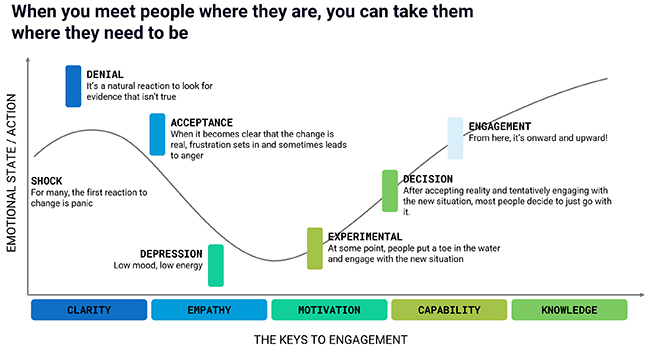
Welcome the change
If we consider an IT organization from the outside, the majority of organizations worldwide are busy continuously reinventing themselves. Some IT organizations find this easier than others, and some have to leave the field completely in the face of these rapid market changes and disappear entirely.

But why is this and how can we do our best to avoid being one of the latter?
In today’s world, it is necessary to be able to react fast and flexible, but also cost-saving and with high quality, to the wishes of the customers.
Charles Darwin, as I have already mentioned in one of my other articles, made what I consider to be a very accurate statement, which is as true today as it was then:
It is not the strongest of the species that survives, nor the most intelligent. It is the one most adaptable to change.
Charles Darwin, 1809
So we should not strive to be the strongest species, but to be able to adapt best. Applied to IT organizations, this means that we should not react reactively to market changes, but should prepare as well as possible for the change that is definitely coming and consider it as part of our DNA.
Manage the change
From classic change management, we should be aware that changes not only have an impact on the IT organization, but also on each individual person within this organization.
Elisabeth Küberl-Ross, an American-Swiss psychiatrist, has described in “The stages of grief” how we react to change and which stages we go through more or less intensively.

It doesn’t seem to matter whether these changes have occurred in the private or professional sphere. We must be mindful that each person has their own way of dealing with change, and we should always meet them where they are and pick them up at the stage they are at.
Organizational performance
Organizational performance measures the ability of an organization to achieve commercial and non-commercial goals. Academic research has validated this measure and found it to be highly correlated to measures of return on investment (ROI), and it is robust to economic cycles.
Combined, commercial and non-commercial goals include:
- Profitability
- Productivity
- Market share
- Number of customers
- Quantity of products or services
- Operating efficiency
- Customer satisfaction
- Quality of products or services provided
- Achieving organization or mission goals
Capabilities and practices
The DevOps Research and Assessment (DORA) team, has identified and validated a set of capabilities and practices that drive higher software delivery and organizational performance. The DORA’s State of DevOps research program includes data from over 31,000 professionals worldwide and has now been conducted regularly every year since 2014.
It is the longest-running, academically rigorous research survey of its kind and provides an independent look at the practices and capabilities that drive high performance in technology delivery and ultimately organizational outcomes. This research uses behavioral science to identify the most effective and efficient ways to develop and deliver software.
If we superimpose the organizational performance goals on the idea of being highly adaptable, we can figure out what a high-performing IT organization will look like. We can keep our goals in mind while still being adaptive to market changes.
The intrinsic motivation to influence the goals is obvious and instead of being blindsided by the external influences, we can equip ourselves well for it with management and technical practices.
Culture and work environment
- Climate for learning: An organization with a climate for learning views learning as an investment that is needed for growth, not as a necessary evil, undertaken only when required.
- Westrum organizational culture: This model of organizational culture was developed by sociologist Dr Ron Westrum. It classifies organizations as pathological, bureaucratic, or generative based on levels of cooperation, how problems are surfaced, the extent to which the organization is siloed, and how people react to failure and novelty.
- Culture of psychological safety: In teams with a culture of psychological safety, team members trust each other, are able to resolve conflict, take calculated and moderate risks, speak up, and are more creative.
- Job satisfaction: People feel supported by their employers, have the tools and resources to do their work, and feel their judgement is valued.
- Identity: Employees identify with the organization they work for. They say that the organization is a good place to work. They feel that the organization cares about them. And they’re willing to put in extra effort to help the organization succeed.
Lean product development
- Working in small batches: The extent to which teams break products and features into small batches that can be completed in less than a week and released frequently, including the use of MVPs (minimum viable products).
- Visibility of work in the value stream: Whether teams understand the workflow from business to customers, and whether they have visibility into this flow, including the status of products and features.
- Customer feedback: Whether organizations actively and regularly seek customer feedback and incorporate it into their product design.
- Team experimentation: Whether development teams have the authority to create and change specifications as part of the development process without requiring approval.
Software delivery and operational performance
- Continuous delivery
- Autonomy, trust and voice
- Cloud infrastructure
- Disaster recovery testing
- No functional outsourcing
- Clear and lightweight change process
- Lean product development
- Lean management practices
I will go into these topics in one of my next articles.